Facile Incorporation of Carbon Nanotubes into the Concrete Matrix Using Lignosulfonate Surfactants
Abstract
1. Introduction
2. Experimental
2.1. Materials
2.2. Methods
2.2.1. Preparation of MWCNT Dispersion
2.2.2. Characterization of MWCNTs
2.2.3. Preparation of Mortars and Fresh Concrete for Analysis
2.2.4. Evaluation of Mortar Consistency
2.2.5. Testing the Setting Time of Mortar
2.2.6. Testing the Consistency of the Concrete Composite
2.2.7. The Methodology of Strength Evaluation
Evaluation of the Flexural Strength of Mortar
Evaluation of the Compressive Strength of Mortar and Concrete
2.2.8. Measurements of the Electrical Impedance
3. Results and Discussion
3.1. Structure of MWCNTs
3.2. Dispersion of MWCNTs
3.3. Consistency and Setting Time
3.4. Mechanical Properties
3.5. Electrical Properties
4. Conclusions
Author Contributions
Funding
Institutional Review Board Statement
Informed Consent Statement
Data Availability Statement
Conflicts of Interest
References
- Jeevanandam, J.; Barhoum, A.; Chan, Y.S.; Dufresne, A.; Danquah, M.K. Review on Nanoparticles and Nanostructured Materials: History, Sources, Toxicity and Regulations. Beilstein J. Nanotechnol. 2018, 9, 1050–1074. [Google Scholar] [CrossRef] [PubMed]
- Kong, W.; Kum, H.; Bae, S.H.; Shim, J.; Kim, H.; Kong, L.; Meng, Y.; Wang, K.; Kim, C.; Kim, J. Path towards Graphene Commercialization from Lab to Market. Nat. Nanotechnol. 2019, 14, 927–938. [Google Scholar] [CrossRef] [PubMed]
- Singh, L.P.; Karade, S.R.; Bhattacharyya, S.K.; Yousuf, M.M.; Ahalawat, S. Beneficial Role of Nanosilica in Cement Based Materials—A Review. Constr. Build. Mater. 2013, 47, 1069–1077. [Google Scholar] [CrossRef]
- Galassi, T.V.; Jena, P.V.; Shah, J.; Ao, G.; Molitor, E.; Bram, Y.; Frankel, A.; Park, J.; Jessurun, J.; Ory, D.S.; et al. An Optical Nanoreporter of Endolysosomal Lipid Accumulation Reveals Enduring Effects of Diet on Hepatic Macrophages in Vivo. Sci. Transl. Med. 2018, 10, eaar2680. [Google Scholar] [CrossRef] [PubMed]
- Liu, Z.; Tabakman, S.; Welsher, K.; Dai, H. Carbon Nanotubes in Biology and Medicine: In Vitro and in Vivo Detection, Imaging and Drug Delivery. Nano Res. 2009, 2, 85–120. [Google Scholar] [CrossRef] [PubMed]
- Gaviria Rojas, W.A.; Hersam, M.C. Chirality-Enriched Carbon Nanotubes for Next-Generation Computing. Adv. Mater. 2020, 32, 1905654. [Google Scholar] [CrossRef]
- Tyson, B.M.; Abu Al-Rub, R.K.; Yazdanbakhsh, A.; Grasley, Z. Carbon Nanotubes and Carbon Nanofibers for Enhancing the Mechanical Properties of Nanocomposite Cementitious Materials. J. Mater. Civ. Eng. 2011, 23, 1028–1035. [Google Scholar] [CrossRef]
- Donchak, V.; Stetsyshyn, Y.; Bratychak, M.; Broza, G.; Harhay, K.; Stepina, N.; Kostenko, M.; Voronov, S. Nanoarchitectonics at Surfaces Using Multifunctional Initiators of Surface-Initiated Radical Polymerization for Fabrication of the Nanocomposites. Appl. Surf. Sci. Adv. 2021, 5, 100104. [Google Scholar] [CrossRef]
- Zhang, J.; Ke, Y.; Zhang, J.; Han, Q.; Dong, B. Cement Paste with Well-Dispersed Multi-Walled Carbon Nanotubes: Mechanism and Performance. Constr. Build. Mater. 2020, 262, 120746. [Google Scholar] [CrossRef]
- Evangelista, A.C.J.; de Morais, J.F.; Tam, V.; Soomro, M.; Di Gregorio, L.T.; Haddad, A.N. Evaluation of Carbon Nanotube Incorporation in Cementitious Composite Materials. Materials 2019, 12, 1504. [Google Scholar] [CrossRef]
- Páez-Pavón, A.; García-Junceda, A.; Galán-Salazar, A.; Merodio-Perea, R.G.; Sánchez del Río, J.; Lado-Touriño, I. Microstructure and Electrical Conductivity of Cement Paste Reinforced with Different Types of Carbon Nanotubes. Materials 2022, 15, 7976. [Google Scholar] [CrossRef] [PubMed]
- Azhari, F.; Banthia, N. Cement-Based Sensors with Carbon Fibers and Carbon Nanotubes for Piezoresistive Sensing. Cem. Concr. Compos. 2012, 34, 866–873. [Google Scholar] [CrossRef]
- Han, B.; Yu, X.; Kwon, E. A Self-Sensing Carbon Nanotube/Cement Composite for Traffic Monitoring. Nanotechnology 2009, 20, 445501. [Google Scholar] [CrossRef] [PubMed]
- Kwon, E.; Yu, X. Carbon Nanotube Based Self-Sensing Concrete for Pavement Structural Health Monitoring; U.S. Department of Transportation: Washington, DC, USA, 2012. [Google Scholar]
- Dalla, P.T.; Dassios, K.G.; Tragazikis, I.K.; Exarchos, D.A.; Matikas, T.E. Carbon Nanotubes and Nanofibers as Strain and Damage Sensors for Smart Cement. Mater. Today Commun. 2016, 8, 196–204. [Google Scholar] [CrossRef]
- Han, B.; Yu, X.; Ou, J. Self-Sensing Concrete in Smart Structures; Elsevier: Amsterdam, The Netherlands, 2014. [Google Scholar] [CrossRef]
- Wen, S.; Chung, D.D.L. Electrical-Resistance-Based Damage Self-Sensing in Carbon Fiber Reinforced Cement. Carbon 2007, 45, 710–716. [Google Scholar] [CrossRef]
- Ding, Y.; Huang, Y.; Zhang, Y.; Jalali, S.; Aguiar, J.B. Self-Monitoring of Freeze-Thaw Damage Using Triphasic Electric Conductive Concrete. Constr. Build. Mater. 2015, 101, 440–446. [Google Scholar] [CrossRef]
- Ding, Y.; Chen, Z.; Han, Z.; Zhang, Y.; Pacheco-Torgal, F. Nano-Carbon Black and Carbon Fiber as Conductive Materials for the Diagnosing of the Damage of Concrete Beam. Constr. Build. Mater. 2013, 43, 233–241. [Google Scholar] [CrossRef]
- Ding, Y.; Han, Z.; Zhang, Y.; Azevedo, C. Hybrid Use of Steel- and Carbon-Fiber Reinforced Concrete for Monitoring of Crack Behavior. In ECCM 2012—Composites at Venice, Proceedings of the 15th European Conference on Composite Materials, Venice, Italy, 24–28 June 2012; University of Padova: Padova, Italy, 2012. [Google Scholar]
- Han, B.; Ding, S.; Yu, X. Intrinsic Self-Sensing Concrete and Structures: A Review. Meas. J. Int. Meas. Confed. 2015, 59, 110–128. [Google Scholar] [CrossRef]
- Fu, X.; Ma, E.; Chung, D.D.L.; Anderson, W.A. Self-Monitoring in Carbon Fiber Reinforced Mortar by Reactance Measurement. Cem. Concr. Res. 1997, 27, 845–852. [Google Scholar] [CrossRef]
- Howser, R.N.; Dhonde, H.B.; Mo, Y.L. Self-Sensing of Carbon Nanofiber Concrete Columns Subjected to Reversed Cyclic Loading. Smart Mater. Struct. 2011, 20, 085031. [Google Scholar] [CrossRef]
- Klein, L.A.; Mills, M.K.; Gibson, D.R.P. Traffic Detector Handbook; FHWA-HRT-06-108; U.S. Department of Transportation, Federal Highway Administration: Washington, DC, USA, 2006. [Google Scholar]
- Gomis, J.; Galao, O.; Gomis, V.; Zornoza, E.; Garcés, P. Self-Heating and Deicing Conductive Cement. Experimental Study and Modeling. Constr. Build. Mater. 2015, 75, 442–449. [Google Scholar] [CrossRef]
- Vera-Agullo, J.; Chozas-Ligero, V.; Portillo-Rico, D.; García-Casas, M.J.; Gutiérrez-Martínez, A.; Mieres-Royo, J.M.; Grávalos-Moreno, J. Mortar and Concrete Reinforced with Nanomaterials. In Nanotechnology in Construction 3; Springer: Berlin/Heidelberg, Germany, 2009. [Google Scholar] [CrossRef]
- Dejaeghere, I.; Sonebi, M.; De Schutter, G. Influence of Nano-Clay on Rheology, Fresh Properties, Heat of Hydration and Strength of Cement-Based Mortars. Constr. Build. Mater. 2019, 222, 73–85. [Google Scholar] [CrossRef]
- Dantas de Oliveira, A.; Augusto Gonçalves Beatrice, C. Polymer Nanocomposites with Different Types of Nanofiller. In Nanocomposites-Recent Evolutions; IntechOpen: London, UK, 2019. [Google Scholar] [CrossRef]
- Silvestre, J.; Silvestre, N.; De Brito, J. Review on Concrete Nanotechnology. Eur. J. Environ. Civ. Eng. 2016, 20, 455–485. [Google Scholar] [CrossRef]
- Czarnecki, L. Sustainable Concrete; Is Nanotechnology the Future of Concrete Polymer Composites? Adv. Mater. Res. 2013, 687, 3–11. [Google Scholar] [CrossRef]
- Sanchez, F.; Sobolev, K. Nanotechnology in Concrete—A Review. Constr. Build. Mater. 2010, 24, 2060–2071. [Google Scholar] [CrossRef]
- Hasan-Nattaj, F.; Nematzadeh, M. The Effect of Forta-Ferro and Steel Fibers on Mechanical Properties of High-Strength Concrete with and without Silica Fume and Nano-Silica. Constr. Build. Mater. 2017, 137, 557–572. [Google Scholar] [CrossRef]
- Fathi, M.; Yousefipour, A.; Hematpoury Farokhy, E. Mechanical and Physical Properties of Expanded Polystyrene Structural Concretes Containing Micro-Silica and Nano-Silica. Constr. Build. Mater. 2017, 136, 590–597. [Google Scholar] [CrossRef]
- Kim, H.K.; Nam, I.W.; Lee, H.K. Enhanced Effect of Carbon Nanotube on Mechanical and Electrical Properties of Cement Composites by Incorporation of Silica Fume. Compos. Struct. 2014, 107, 60–69. [Google Scholar] [CrossRef]
- Ürk, D.; Demir, E.; Bulut, O.; Çakıroğlu, D.; Cebeci, F.; Lütfi Öveçoğlu, M.; Cebeci, H. Understanding the Polymer Type and CNT Orientation Effect on the Dynamic Mechanical Properties of High Volume Fraction CNT Polymer Nanocomposites. Compos. Struct. 2016, 155, 255–262. [Google Scholar] [CrossRef]
- Ludvig, P.; Calixto, J.M.; Ladeira, L.O.; Gaspar, I.C.P. Using Converter Dust to Produce Low Cost Cementitious Composites by in Situ Carbon Nanotube and Nanofiber Synthesis. Materials 2011, 4, 575–584. [Google Scholar] [CrossRef]
- Morsy, M.S.; Alsayed, S.H.; Aqel, M. Hybrid Effect of Carbon Nanotube and Nano-Clay on Physico-Mechanical Properties of Cement Mortar. Constr. Build. Mater. 2011, 25, 145–149. [Google Scholar] [CrossRef]
- Li, G.Y.; Wang, P.M.; Zhao, X. Mechanical Behavior and Microstructure of Cement Composites Incorporating Surface-Treated Multi-Walled Carbon Nanotubes. Carbon 2005, 43, 1239–1245. [Google Scholar] [CrossRef]
- Chaipanich, A.; Nochaiya, T.; Wongkeo, W.; Torkittikul, P. Compressive Strength and Microstructure of Carbon Nanotubes-Fly Ash Cement Composites. Mater. Sci. Eng. A 2010, 527, 1063–1067. [Google Scholar] [CrossRef]
- Musso, S.; Tulliani, J.M.; Ferro, G.; Tagliaferro, A. Influence of Carbon Nanotubes Structure on the Mechanical Behavior of Cement Composites. Compos. Sci. Technol. 2009, 69, 1985–1990. [Google Scholar] [CrossRef]
- Konsta-Gdoutos, M.S.; Metaxa, Z.S.; Shah, S.P. Multi-Scale Mechanical and Fracture Characteristics and Early-Age Strain Capacity of High Performance Carbon Nanotube/Cement Nanocomposites. Cem. Concr. Compos. 2010, 32, 110–115. [Google Scholar] [CrossRef]
- Sun, S.; Yu, X.; Han, B.; Ou, J. In Situ Growth of Carbon Nanotubes/Carbon Nanofibers on Cement/Mineral Admixture Particles: A Review. Constr. Build. Mater. 2013, 49, 835–840. [Google Scholar] [CrossRef]
- Stynoski, P.; Mondal, P.; Marsh, C. Effects of Silica Additives on Fracture Properties of Carbon Nanotube and Carbon Fiber Reinforced Portland Cement Mortar. Cem. Concr. Compos. 2015, 55, 232–240. [Google Scholar] [CrossRef]
- Torabian Isfahani, F.; Li, W.; Redaelli, E. Dispersion of Multi-Walled Carbon Nanotubes and Its Effects on the Properties of Cement Composites. Cem. Concr. Compos. 2016, 74, 154–163. [Google Scholar] [CrossRef]
- Jiang, L.; Gao, L.; Sun, J. Production of Aqueous Colloidal Dispersions of Carbon Nanotubes. J. Colloid Interface Sci. 2003, 260, 89–94. [Google Scholar] [CrossRef]
- Qiu, L.; Yang, X.; Gou, X.; Yang, W.; Ma, Z.F.; Wallace, G.G.; Li, D. Dispersing Carbon Nanotubes with Graphene Oxide in Water and Synergistic Effects between Graphene Derivatives. Chem.-Eur. J. 2010, 16, 10653–10658. [Google Scholar] [CrossRef]
- Vaisman, L.; Wagner, H.D.; Marom, G. The Role of Surfactants in Dispersion of Carbon Nanotubes. Adv. Colloid Interface Sci. 2006, 128–130, 37–46. [Google Scholar] [CrossRef] [PubMed]
- Liew, K.M.; Wong, C.H.; Tan, M.J. Tensile and Compressive Properties of Carbon Nanotube Bundles. Acta Mater. 2006, 54, 225–231. [Google Scholar] [CrossRef]
- Kis, A.; Csányi, G.; Salvetat, J.P.; Lee, T.N.; Couteau, E.; Kulik, A.J.; Benoit, W.; Brugger, J.; Forró, L. Reinforcement of Single-Walled Carbon Nanotube Bundles by Intertube Bridging. Nat. Mater. 2004, 3, 153–157. [Google Scholar] [CrossRef]
- Abu Al-Rub, R.K.; Tyson, B.M.; Yazdanbakhsh, A.; Grasley, Z. Mechanical Properties of Nanocomposite Cement Incorporating Surface-Treated and Untreated Carbon Nanotubes and Carbon Nanofibers. J. Nanomech. Micromech. 2012, 2, 1–6. [Google Scholar] [CrossRef]
- Hu, Y.; Luo, D.; Li, P.; Li, Q.; Sun, G. Fracture Toughness Enhancement of Cement Paste with Multi-Walled Carbon Nanotubes. Constr. Build. Mater. 2014, 70, 332–338. [Google Scholar] [CrossRef]
- Collins, F.; Lambert, J.; Duan, W.H. The Influences of Admixtures on the Dispersion, Workability, and Strength of Carbon Nanotube-OPC Paste Mixtures. Cem. Concr. Compos. 2012, 34, 201–207. [Google Scholar] [CrossRef]
- del Carmen Camacho, M.; Galao, O.; Baeza, F.J.; Zornoza, E.; Garcés, P. Mechanical Properties and Durability of CNT Cement Composites. Materials 2014, 7, 1640–1651. [Google Scholar] [CrossRef] [PubMed]
- Zhou, C.; Li, F.; Hu, J.; Ren, M.; Wei, J.; Yu, Q. Enhanced Mechanical Properties of Cement Paste by Hybrid Graphene Oxide/Carbon Nanotubes. Constr. Build. Mater. 2017, 134, 336–345. [Google Scholar] [CrossRef]
- Lu, Z.; Hanif, A.; Ning, C.; Shao, H.; Yin, R.; Li, Z. Steric Stabilization of Graphene Oxide in Alkaline Cementitious Solutions: Mechanical Enhancement of Cement Composite. Mater. Des. 2017, 127, 154–161. [Google Scholar] [CrossRef]
- Arrigo, R.; Teresi, R.; Gambarotti, C.; Parisi, F.; Lazzara, G.; Dintcheva, N.T. Sonication-Induced Modification of Carbon Nanotubes: Effect on the Rheological and Thermo-Oxidative Behaviour of Polymer-Based Nanocomposites. Materials 2018, 11, 383. [Google Scholar] [CrossRef]
- Shea, M.J.; Wang, J.; Flach, J.T.; Zanni, M.T.; Arnold, M.S. Less Severe Processing Improves Carbon Nanotube Photovoltaic Performance. APL Mater. 2018, 6, 056104. [Google Scholar] [CrossRef]
- Mendoza, O.; Sierra, G.; Tobón, J.I. Influence of Super Plasticizer and Ca(OH)2 on the Stability of Functionalized Multi-Walled Carbon Nanotubes Dispersions for Cement Composites Applications. Constr. Build. Mater. 2013, 47, 771–778. [Google Scholar] [CrossRef]
- Lekawa-Raus, A.; Patmore, J.; Kurzepa, L.; Bulmer, J.; Koziol, K. Electrical Properties of Carbon Nanotube Based Fibers and Their Future Use in Electrical Wiring. Adv. Funct. Mater. 2014, 24, 3661–3682. [Google Scholar] [CrossRef]
- Datsyuk, V.; Kalyva, M.; Papagelis, K.; Parthenios, J.; Tasis, D.; Siokou, A.; Kallitsis, I.; Galiotis, C. Chemical Oxidation of Multiwalled Carbon Nanotubes. Carbon 2008, 46, 833–840. [Google Scholar] [CrossRef]
- Rastogi, R.; Kaushal, R.; Tripathi, S.K.; Sharma, A.L.; Kaur, I.; Bharadwaj, L.M. Comparative Study of Carbon Nanotube Dispersion Using Surfactants. J. Colloid Interface Sci. 2008, 328, 421–428. [Google Scholar] [CrossRef] [PubMed]
- Adresi, M.; Hassani, A.; Javadian, S.; Tulliani, J.M. Determining the Surfactant Consistent with Concrete in Order to Achieve the Maximum Possible Dispersion of Multiwalled Carbon Nanotubes in Keeping the Plain Concrete Properties. J. Nanotechnol. 2016, 2016, 2864028. [Google Scholar] [CrossRef]
- Takeda, M.; Otsuka, K.; Moriyoshi, A. The Surfactant Effect on the Degradation of the Concrete. J. Appl. Mech. 2010, 6, 1189. [Google Scholar] [CrossRef]
- Ouchi, M.; Hibino, M.; Okamura, H. Effect of Superplasticizer on Self-Compactability of Fresh Concrete. Transp. Res. Rec. J. Transp. Res. Board 1997, 1574, 37–40. [Google Scholar] [CrossRef]
- Collepardi, M. Admixtures Used to Enhance Placing Characteristics of Concrete. Cem. Concr. Compos. 1998, 20, 103–112. [Google Scholar] [CrossRef]
- El Gamal, S.M.; Bin Salman, H.M. Effect of Addition of Sikament-R Superplasticizer on the Hydration Characteristics of Portland Cement Pastes. HBRC J. 2012, 8, 75–80. [Google Scholar] [CrossRef][Green Version]
- Kim, J.-H.; Park, S.-H.; Chung, C.-W. The Properties of Cement Paste Incorporating Multi Wall Carbon Nanotube Solution Prepared through Bead Mill and High-Pressure Homogenizer Process with Polycarboxylate Ester. Constr. Build. Mater. 2022, 337, 127598. [Google Scholar] [CrossRef]
- Vesmawala, G.R.; Vaghela, A.R.; Yadav, K.D.; Patil, Y. Effectiveness of Polycarboxylate as a Dispersant of Carbon Nanotubes in Concrete. Mater. Today Proc. 2020, 28, 10–14. [Google Scholar] [CrossRef]
- Karpova, E.; Skripkiūnas, G.; Barauskas, I.; Barauskienė, I.; Hodul, J. Influence of Carbon Nanotubes and Polycarboxylate Superplasticiser on the Portland Cement Hydration Process. Constr. Build. Mater. 2021, 304, 124648. [Google Scholar] [CrossRef]
- PN EN 196-1: 2016; Methods of Testing Cement—Part 1: Determination of Strength. Polish Committee for Standardization (PKN): Warsaw, Poland, 2016.
- PN-EN 1015-3: 2000; Methods of Test for Mortar for Masonry—Part 3: Determination of Consistence of Fresh Mortar (by Flow Ttable). Polish Committee for Standardization (PKN): Warsaw, Poland, 2000.
- PN-EN 1015-4: 2000; Test Methods for Masonry Mortars—Determination of the Consistency of Fresh Mortar (by Probe Penetration). Polish Committee for Standardization (PKN): Warsaw, Poland, 2000.
- PN-EN 480-2:2004; Admixtures for Concrete, Mortar and Grout—Test Methods—Part 2: Determination of Setting Time. Polish Committee for Standardization (PKN): Warsaw, Poland, 2004.
- PN-EN 12350-5:2019; Testing Fresh Concrete—Part 5: Flow Table Test. Polish Committee for Standardization (PKN): Warsaw, Poland, 2019.
- PN-EN 1015-11:2020; Test Methods for Masonry Mortars—Part 11: Determination of Flexural and Compressive Strength of Hardened Mortar. Polish Committee for Standardization (PKN): Warsaw, Poland, 2020.
- PN-EN 12390-1:2013-03; Testing Hardened Concrete—Part 1: Shape, Dimensions and Other Requirements for Specimens and Moulds. Polish Committee for Standardization (PKN): Warsaw, Poland, 2013.
- Zampiva, R.Y.S.; Kaufmann Junior, C.G.; Pinto, J.S.; Panta, P.C.; Alves, A.K.; Bergmann, C.P. 3D CNT Macrostructure Synthesis Catalyzed by MgFe2O4 Nanoparticles—A Study of Surface Area and Spinel Inversion Influence. Appl. Surf. Sci. 2017, 422, 321–330. [Google Scholar] [CrossRef]
- Janas, D.; Czechowski, N.; Adamus, Z.; Giżewski, T. Electronic and Magneto-Transport in Chirality Sorted Carbon Nanotube Films. Appl. Phys. Lett. 2018, 112, 53104. [Google Scholar] [CrossRef]
- White, C.M.; Banks, R.; Hamerton, I.; Watts, J.F. Characterisation of Commercially CVD Grown Multi-Walled Carbon Nanotubes for Paint Applications. Prog. Org. Coat. 2016, 90, 44–53. [Google Scholar] [CrossRef]
- Zhang, T.; Shang, S.; Yin, F.; Aishah, A.; Salmiah, A.; Ooi, T.L. Adsorptive Behavior of Surfactants on Surface of Portland Cement. Cem. Concr. Res. 2001, 31, 1009–1015. [Google Scholar] [CrossRef]
- Zhang, R.; Somasundaran, P. Advances in Adsorption of Surfactants and Their Mixtures at Solid/Solution Interfaces. Adv. Colloid Interface Sci. 2006, 123–126, 213–229. [Google Scholar] [CrossRef]
- Avendano, C.; Brun, N.; Fontaine, O.; In, M.; Mehdi, A.; Stocco, A.; Vioux, A. Multiwalled Carbon Nanotube/Cellulose Composite: From Aqueous Dispersions to Pickering Emulsions. Langmuir 2016, 32, 3907–3916. [Google Scholar] [CrossRef]
- Janas, D.; Rdest, M.; Koziol, K.K.K. Free-Standing Films from Chirality-Controlled Carbon Nanotubes. Mater. Des. 2017, 121, 119–125. [Google Scholar] [CrossRef]
- Chen, J.; Eraghi Kazzaz, A.; AlipoorMazandarani, N.; Hosseinpour Feizi, Z.; Fatehi, P. Production of Flocculants, Adsorbents, and Dispersants from Lignin. Molecules 2018, 23, 868. [Google Scholar] [CrossRef] [PubMed]
- Hanehara, S.; Yamada, K. Interaction between Cement and Chemical Admixture from the Point of Cement Hydration, Absorption Behaviour of Admixture, and Paste Rheology. Cem. Concr. Res. 1999, 29, 1159–1165. [Google Scholar] [CrossRef]
- Kim, B.-G.; Jiang, S.; Jolicoeur, C.; Aïtcin, P.-C. The Adsorption Behavior of PNS Superplasticizer and Its Relation to Fluidity of Cement Paste. Cem. Concr. Res. 2000, 30, 887–893. [Google Scholar] [CrossRef]
- Ahmad, S.; Lawan, A.; Al-osta, M. Case Studies in Construction Materials Effect of Sugar Dosage on Setting Time, Microstructure and Strength of Type I and Type V Portland Cements. Case Stud. Constr. Mater. 2020, 13, e00364. [Google Scholar] [CrossRef]
- Colombo, A.; Geiker, M.R.; Justnes, H.; Lauten, R.A.; De Weerdt, K. On the Effect of Calcium Lignosulfonate on the Rheology and Setting Time of Cement Paste. Cem. Concr. Res. 2017, 100, 435–444. [Google Scholar] [CrossRef]
- PN-EN 1015-6:2000; Methods of Test for Mortar for Masonry—Part 6: Determination of Bulk Density of Fresh Mortar. Polish Committee for Standardization (PKN): Warsaw, Poland, 2000.
- Sobolkina, A.; Mechtcherine, V.; Khavrus, V.; Maier, D.; Mende, M.; Ritschel, M.; Leonhardt, A. Dispersion of Carbon Nanotubes and Its Influence on the Mechanical Properties of the Cement Matrix. Cem. Concr. Compos. 2012, 34, 1104–1113. [Google Scholar] [CrossRef]
- Skripkiunas, G.; Karpova, E.; Barauskas, I.; Bendoraitiene, J.; Yakovlev, G. Rheological Properties of Cement Pastes with Multiwalled Carbon Nanotubes. Adv. Mater. Sci. Eng. 2018, 2018, 8963542. [Google Scholar] [CrossRef]
- Jiang, S.; Shan, B.; Ouyang, J.; Zhang, W.; Yu, X.; Li, P.; Han, B. Rheological Properties of Cementitious Composites with Nano/Fiber Fillers. Constr. Build. Mater. 2018, 158, 786–800. [Google Scholar] [CrossRef]
- Mendoza, O.; Arias, Y.; Ochoa, J.; Delgado, C.; Quintero, J.; Toledo Filho, R. Influence of MWCNT/Surfactant Dispersions on the Rheology of Portland Cement Pastes. Cem. Concr. Res. 2018, 107, 101–109. [Google Scholar] [CrossRef]
- Kostrzanowska-Siedlarz, A. Statistical Methods for Determining Rheological Parameters of Mortars Modified with Multi-Walled Carbon Nanotubes. Constr. Build. Mater. 2020, 253, 119213. [Google Scholar] [CrossRef]
- Manzur, T.; Yazdani, N.; Emon, M.A.B. Potential of Carbon Nanotube Reinforced Cement Composites as Concrete Repair Material. J. Nanomater. 2016, 2016, 1421959. [Google Scholar] [CrossRef]
- Sarvandani, M.M.; Mahdikhani, M.; Aghabarati, H.; Fatmehsari, M.H. Effect of Functionalized Multi-Walled Carbon Nanotubes on Mechanical Properties and Durability of Cement Mortars. J. Build. Eng. 2021, 41, 102407. [Google Scholar] [CrossRef]
- Hawreen, A.; Bogas, J.A.; Dias, A.P.S. On the Mechanical and Shrinkage Behavior of Cement Mortars Reinforced with Carbon Nanotubes. Constr. Build. Mater. 2018, 168, 459–470. [Google Scholar] [CrossRef]
- Ahmed, H.; Bogas, J.; Guedes, M.; Pereira, M. Mechanical Characterization of Cement Pastes Reinforced with Pristine and Functionalized Multi-Walled Carbon Nanotubes. In Proceedings of the XVIII Congresso da Sociedade Portuguesa de Materiais, Aveiro, Portugal, 9–12 April 2017. [Google Scholar]
- Cwirzen, A.; Habermehl-Cwirzen, K.; Penttala, V. Surface Decoration of Carbon Nanotubes and Mechanical Properties of Cement/Carbon Nanotube Composites. Adv. Cem. Res. 2008, 20, 65–73. [Google Scholar] [CrossRef]
- Tamimi, A.; Hassan, N.M.; Fattah, K.; Talachi, A. Performance of Cementitious Materials Produced by Incorporating Surface Treated Multiwall Carbon Nanotubes and Silica Fume. Constr. Build. Mater. 2016, 114, 934–945. [Google Scholar] [CrossRef]
- Kumar, S.; Kolay, P.; Malla, S.; Mishra, S. Effect of Multiwalled Carbon Nanotubes on Mechanical Strength of Cement Paste. J. Mater. Civ. Eng. 2012, 24, 84–91. [Google Scholar] [CrossRef]
- Banfill, P. The Rheology of Fresh Cement and Concrete—A Review. In Proceedings of the 11th International Cement Chemistry Congress, Durban, South Africa, 11–16 May 2003. [Google Scholar]
- Petit, J.-Y.; Wirquin, E.; Vanhove, Y.; Khayat, K. Yield Stress and Viscosity Equations for Mortars and Self-Consolidating Concrete. Cem. Concr. Res. 2007, 37, 655–670. [Google Scholar] [CrossRef]
- Gołaszewski, J. Correlation between Rheology of Superplasticized Fresh Mortars and Fresh Concretes. In Proceedings of the Ninth ACI International Conference on Superplasticizers and Other Chemical Admixtures, Seville, Spain, 13 October 2009; Volume 262, pp. 215–235. [Google Scholar]
- Gołaszewski, J.; Cygan, G. The Effect of Temperature on the Rheological Properties of Self-Compacting Concrete. In Brittle Matrix Composites 9; Woodhead Publishing Limited: Cambridge, UK, 2009; pp. 359–368. [Google Scholar] [CrossRef]
- Gołaszewski, J.; Kostrzanowska-Siedlarz, A.; Cygan, G.; Drewniok, M. Mortar as a Model to Predict Self-Compacting Concrete Rheological Properties as a Function of Time and Temperature. Constr. Build. Mater. 2016, 124, 1100–1108. [Google Scholar] [CrossRef]
- Norberg, J.; Peterson; Norberg, P.; Billberg, P. Effects of a New Generation of Superplasticizers on the Properties of Fresh Concrete. In Proceedings of the Fifth CANMET/ACI International Conference on Superplasticizers and Other Chemical Admixtures in Concrete, Rome, Italy, 7 October 1997. [Google Scholar]
- Kang, M.-S.; Lee, H.; Yim, H.J.; An, Y.-K.; Kim, D.J. Multi-Channel Electrical Impedance-Based Crack Localization of Fiber-Reinforced Cementitious Composites under Bending Conditions. Appl. Sci. 2018, 8, 2582. [Google Scholar] [CrossRef]
- Suryanto, B.; Takaoka, H.; McCater, W.J.; Saraireh, D.; Taha, H. Impedance Measurements on an Engineered Cementitious Composite: A Critical Evaluation of Testing Protocols. Measurement 2018, 129, 445–456. [Google Scholar] [CrossRef]
- Drozdov, G.; Xu, H.; Frauenheim, T.; Dumitrică, T. Densely-Packed Bundles of Collapsed Carbon Nanotubes: Atomistic and Mesoscopic Distinct Element Method Modeling. Carbon 2019, 152, 198–205. [Google Scholar] [CrossRef]
- Mann, F.A.; Herrmann, N.; Opazo, F.; Kruss, S. Quantum Defects as a Toolbox for the Covalent Functionalization of Carbon Nanotubes with Peptides and Proteins. Angew. Chem. Int. Ed. 2020, 59, 17732–17738. [Google Scholar] [CrossRef] [PubMed]
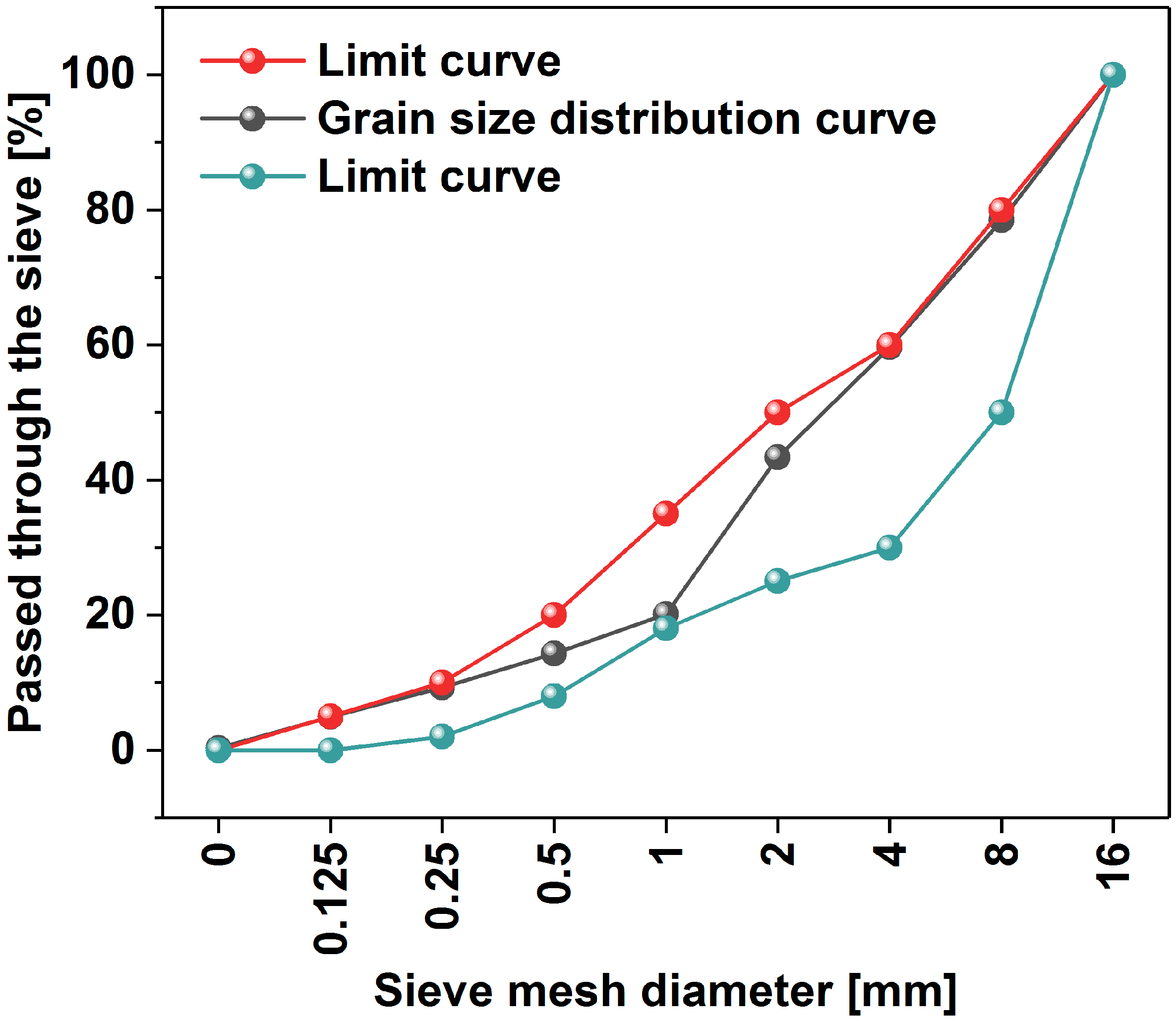

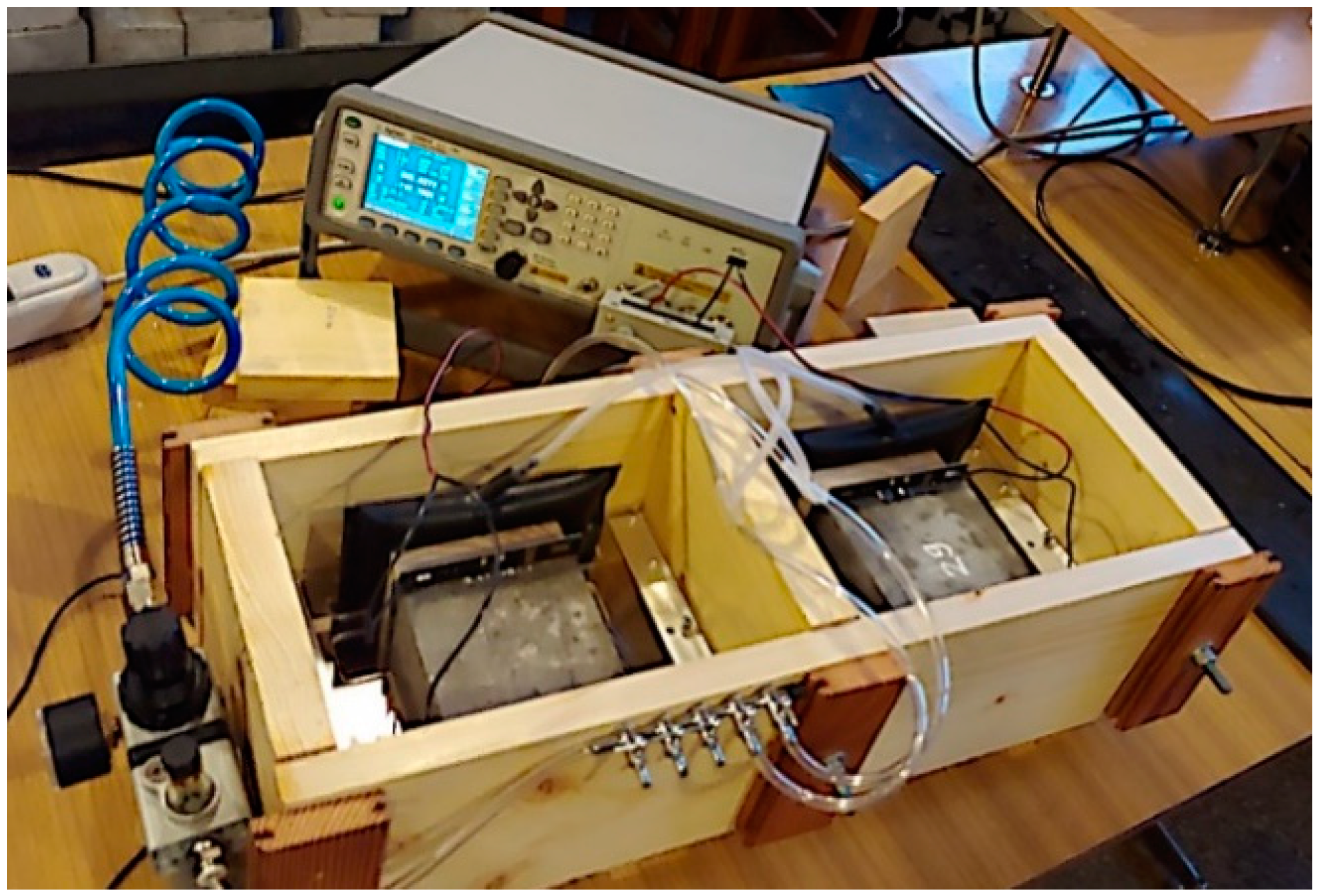
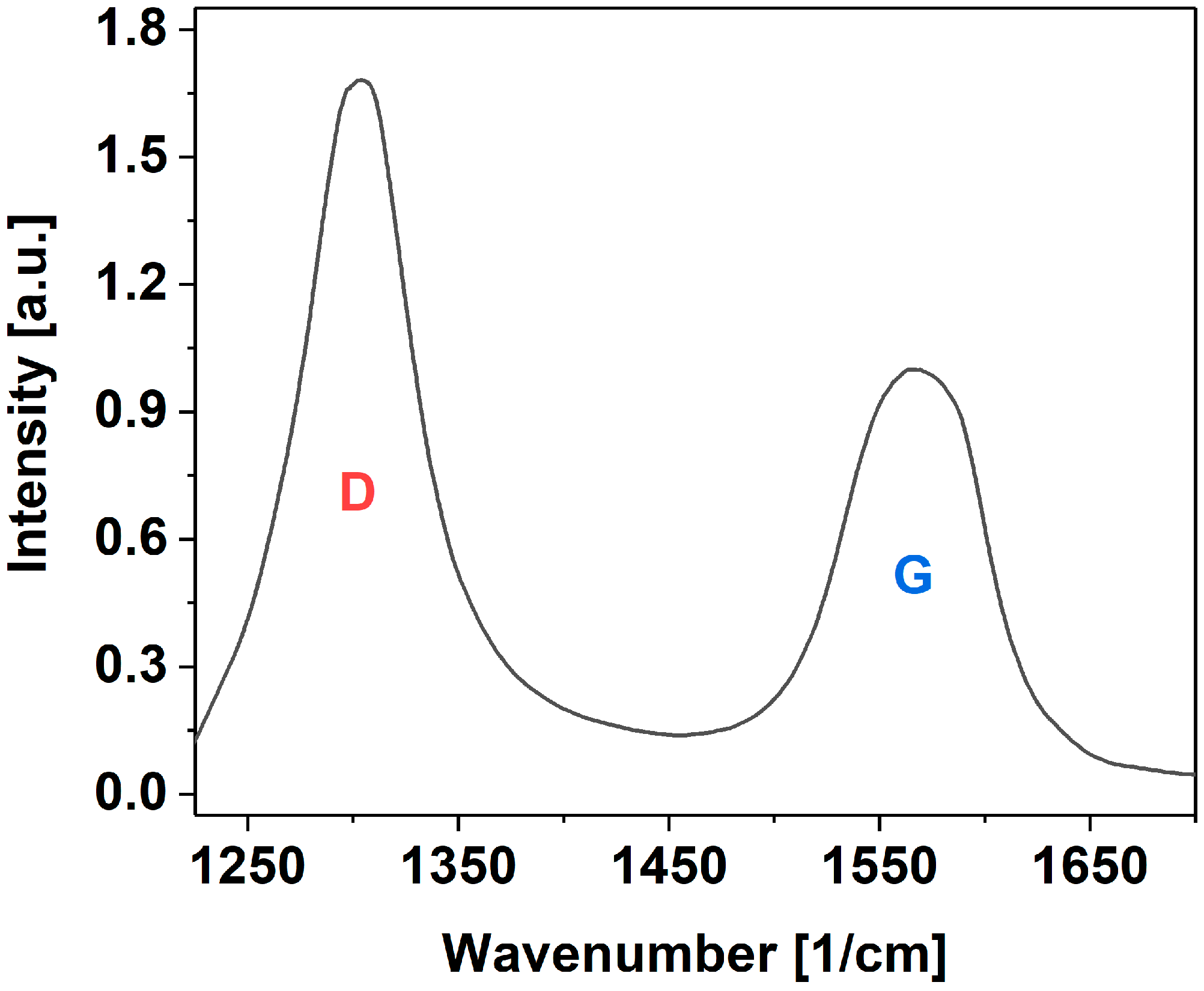
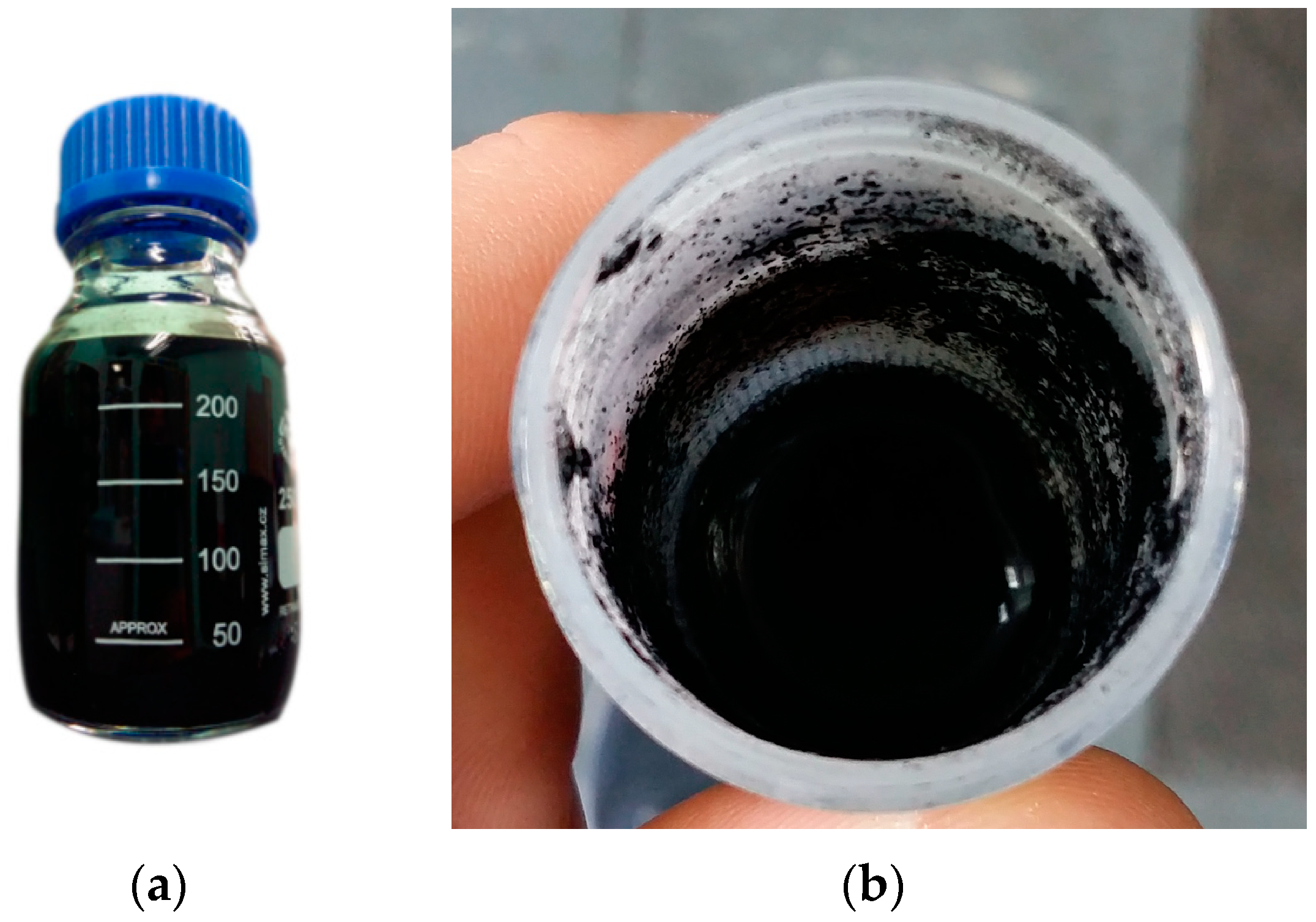
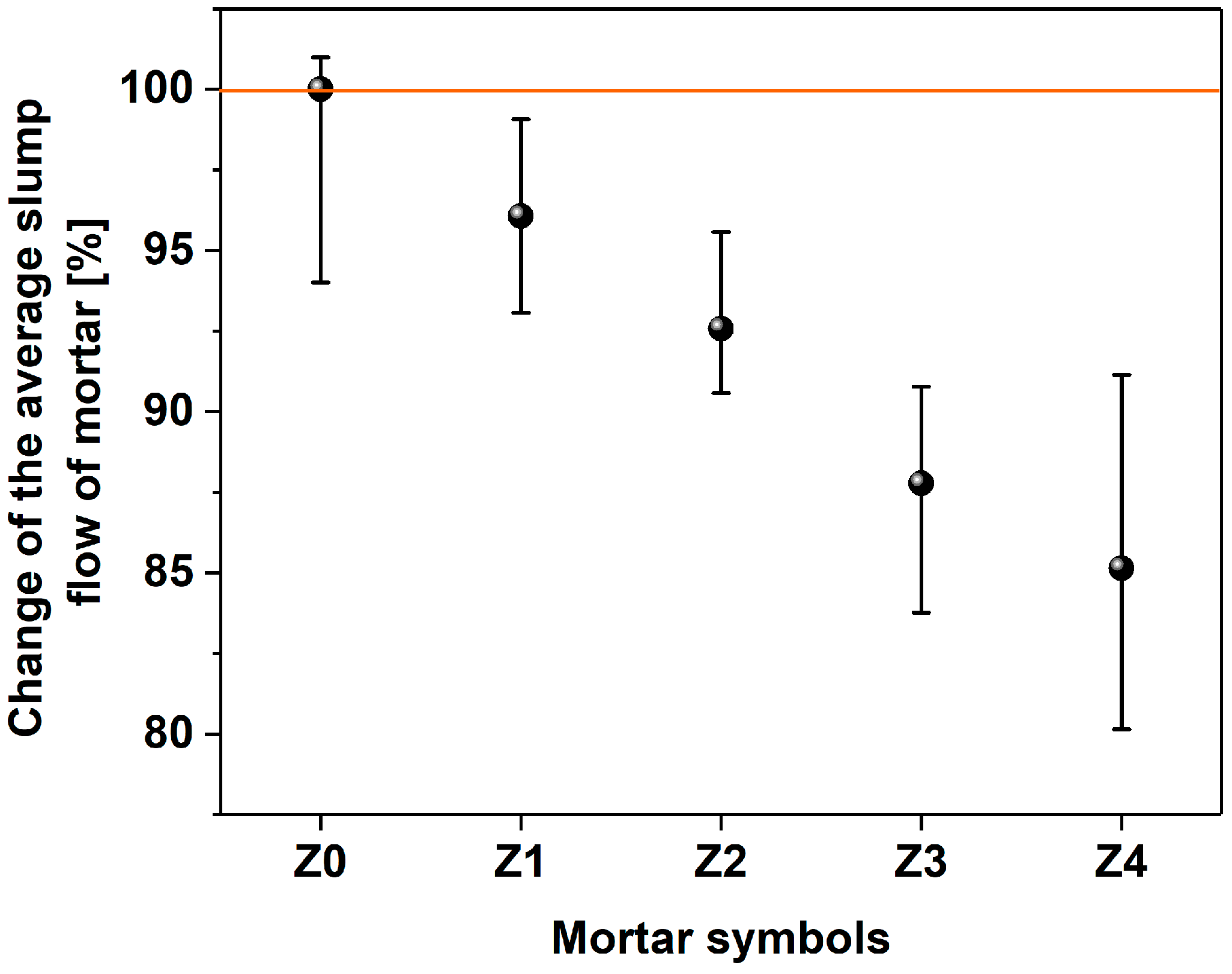
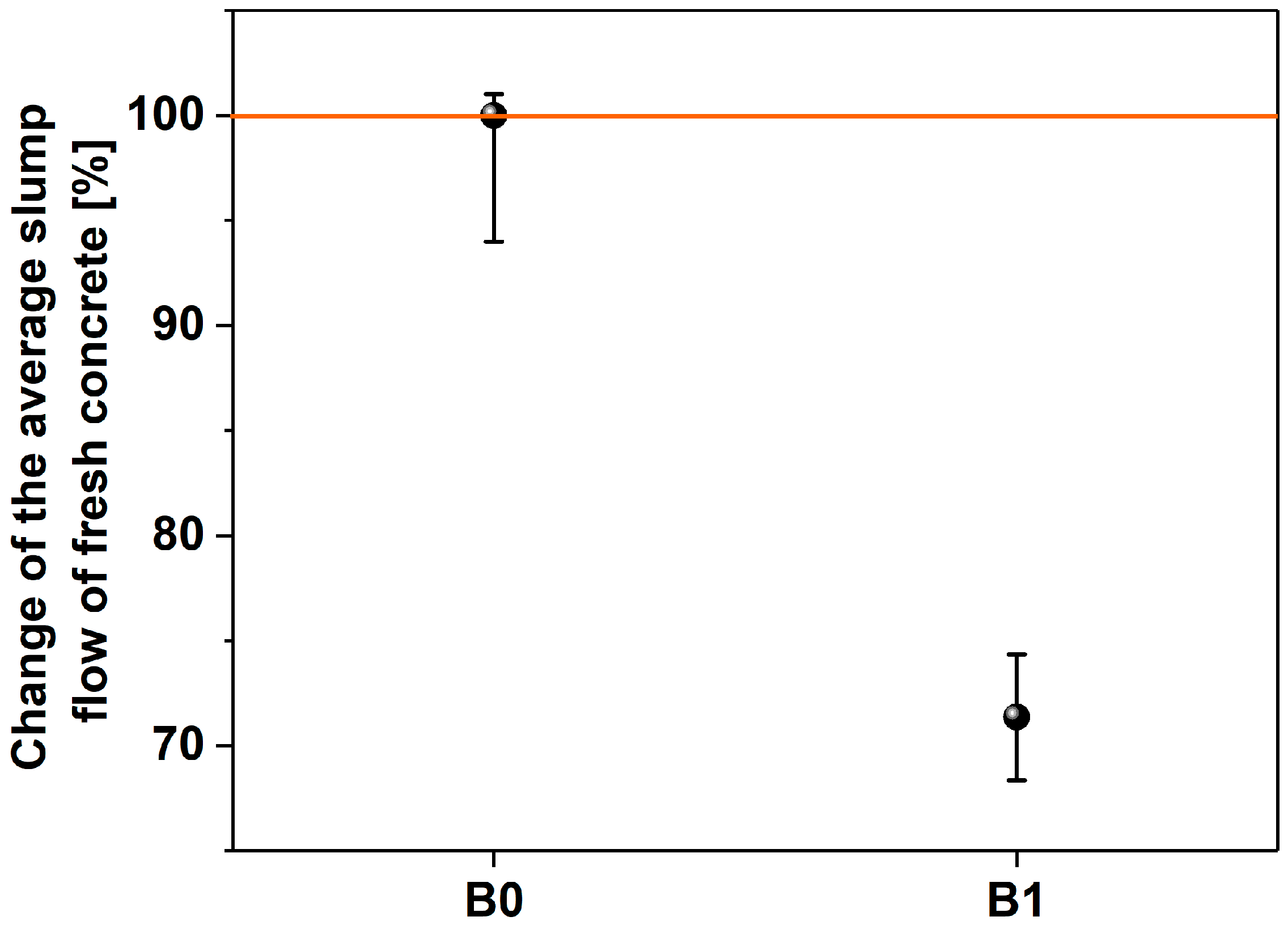

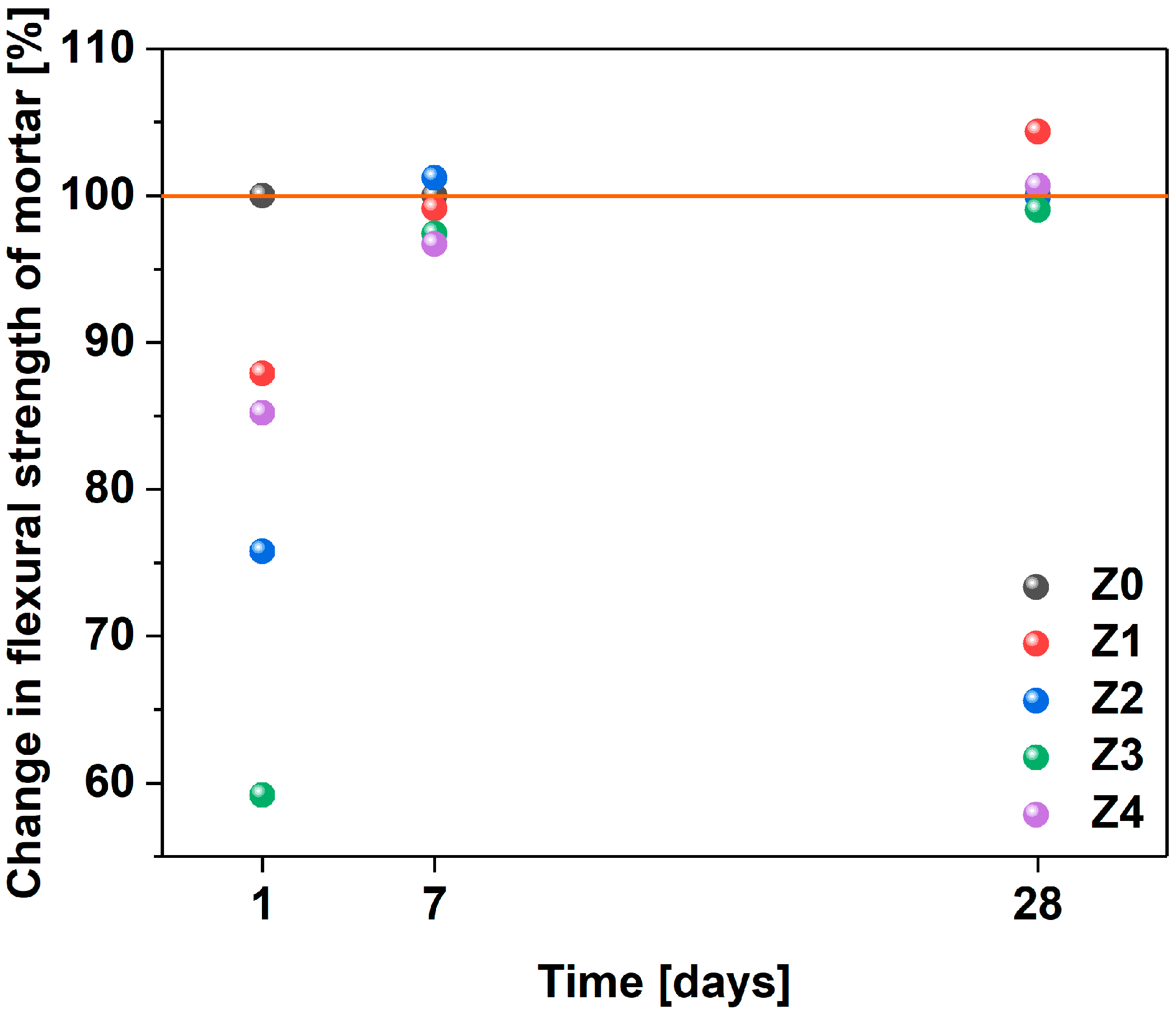
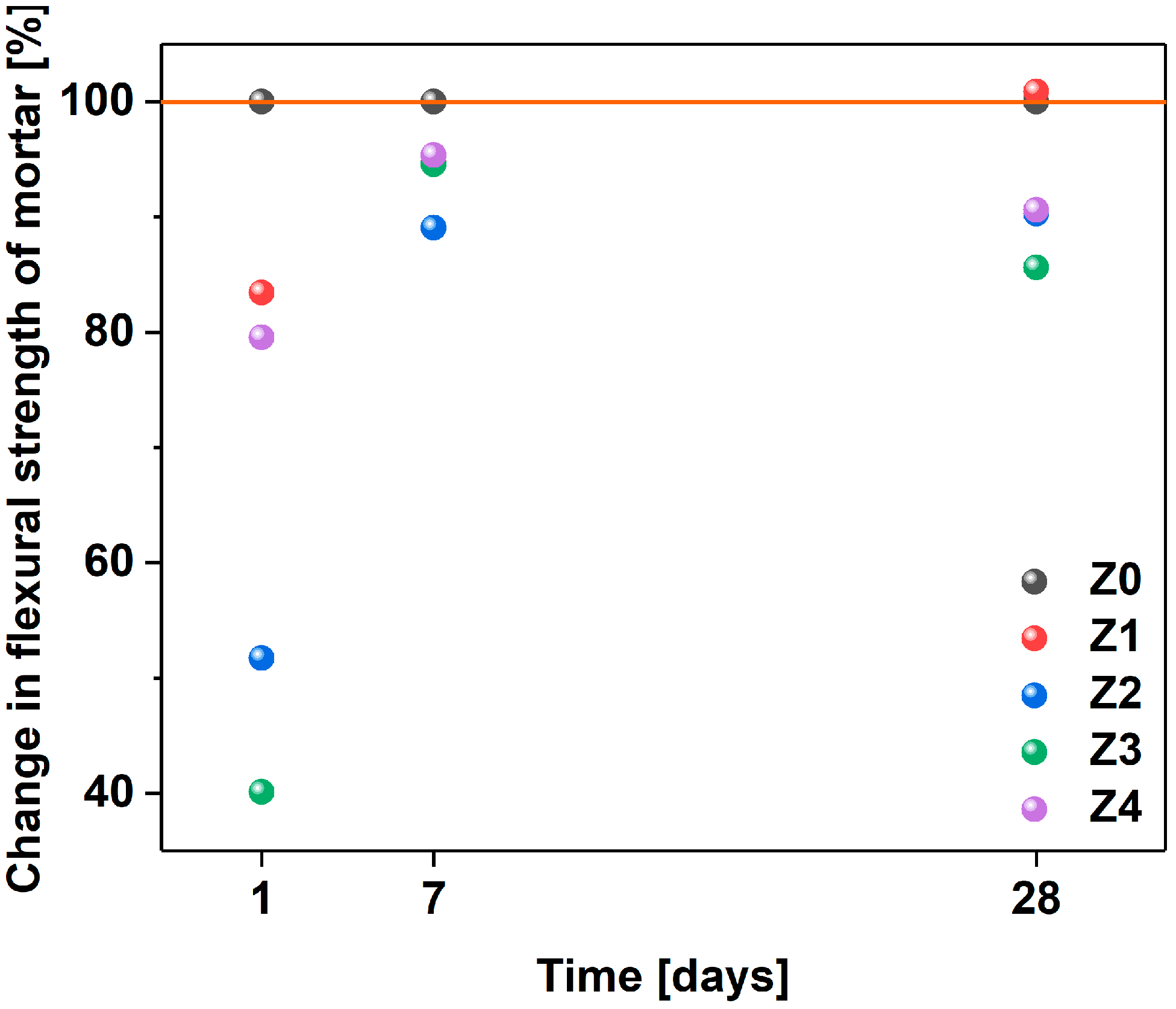
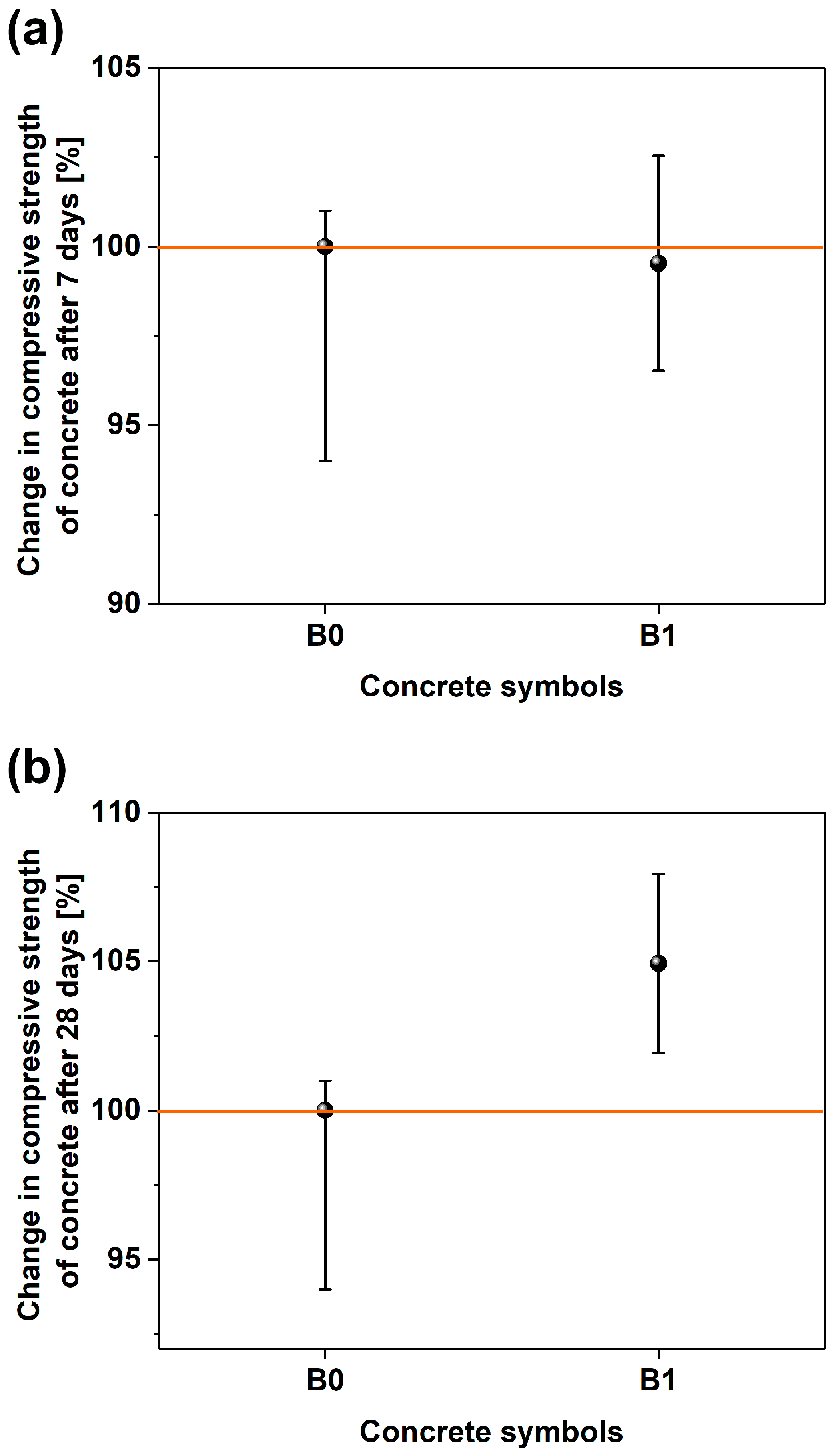

| Composition [wt%] | Loss on Ignition [wt%] | Insoluble Parts [wt%] | The Specific Surface Area [m2/kg] | |||||||
|---|---|---|---|---|---|---|---|---|---|---|
| SiO2 | CaO | Al2O3 | Fe2O3 | MgO | Na2O | SO3 | K2O | |||
| 21.6 | 64.41 | 4.46 | 2.24 | 1.25 | 0.4 | 3.1 | 0.91 | 2.0 | 0.4 | 383 |
| Properties | Results | |
|---|---|---|
| Changes in volume, Le Chatelier | 0.0 mm3 | |
| Beginning of setting time | 175 min | |
| Compressive strength | After 2 days | 27.6 MPa |
| After 28 days | 53.4 MPa | |
| Admixture | Chemical Base | Density [g/cm3] | pH at 20 °C | Chloride Content [wt%] | Alkali Content [wt%] |
|---|---|---|---|---|---|
| MAPEI (SP1) | acrylic polymers | 1.06 ± 0.02 | 6.5 ± 1.0 | ≤0.1% | ≤3.0% |
| MAPEI (SP2) | acrylic polymers (without formaldehyde) | 1.06 ± 0.02 | 7.0 ± 1.0 | ≤0.1% | ≤2.0% |
| BASF (SP3) | (carboxylate ether) polymers | 1.06 ± 0.02 | 6.0 ± 1.0 | ≤0.1% | ≤0.6% |
| BASF (SP4) | (carboxylate ether) polymers | 1.07 ± 0.02 | 6.5 ± 1.0 | ≤0.1% | ≤1.5% |
| MAPEI (PL1) | lignosulfonate | 1.16 | 8.5 | ≤0.1% | ≤6.0% |
| No. | Symbol of Admixture | The Name of the Admixture | The Manufacturer | Amount of MWCNTs [g] | Amount of Admixture [g] | Amount of Water [g] | Sonication Power [%] | Sonication Time [min] |
|---|---|---|---|---|---|---|---|---|
| 1 | SP1 | Dynamon NRG 1022 | MAPEI (Gliwice, Poland) | 0.250 | 0.250 | 25 | 100% | 03:20 |
| 2 | SP1 | Dynamon NRG 1022 | MAPEI | 0.060 | 0.090 | 25 | 40% | 03:20 |
| 3 | SP1 | Dynamon NRG 1022 | MAPEI | 0.125 | 0.250 | 25 | 40% | 03:20 |
| 4 | SP1 | Dynamon NRG 1022 | MAPEI | 0.125 | 0.500 | 25 | 40% | 03:20 |
| 5 | SP1 | Dynamon NRG 1022 | MAPEI | 0.125 | 1.000 | 25 | 40% | 03:20 |
| 6 | SP1 | Dynamon NRG 1022 | MAPEI | 0.060 | 0.125 | 25 | 40% | 03:20 |
| 7 | SP1 | Dynamon NRG 1022 | MAPEI | 0.125 | 0.125 | 25 | 40% | 04:20 |
| 8 | SP1 | Dynamon NRG 1022 | MAPEI | 0.030 | 0.040 | 25 | 40% | 30:00 |
| 9 | SP2 | Dynamon SR1 | MAPEI | 0.125 | 0.125 | 25 | 40% | 03:20 |
| 10 | SP2 | Dynamon SR1 | MAPEI | 0.125 | 0.250 | 25 | 40% | 03:20 |
| 11 | SP2 | Dynamon SR1 | MAPEI | 0.125 | 0.500 | 25 | 40% | 03:20 |
| 12 | SP2 | Dynamon SR1 | MAPEI | 0.125 | 1.000 | 25 | 40% | 03:20 |
| 13 | SP2 | Dynamon SR1 | MAPEI | 0.060 | 0.060 | 25 | 40% | 03:20 |
| 14 | SP2 | Dynamon SR1 | MAPEI | 0.060 | 0.125 | 25 | 40% | 03:20 |
| 15 | SP2 | Dynamon SR1 | MAPEI | 0.600 | 1.250 | 250 | 60% | 120:00 |
| 16 | SP3 | MasterGlenium ACE 430 | BASF (Warsaw, Poland) | 0.030 | 0.030 | 25 | 40% | 30:00 |
| 17 | SP4 | MasterGlenium SKY 591 | BASF | 0.030 | 0.040 | 25 | 40% | 30:00 |
| 18 | PL1 | Mapeplast BV 34 | MAPEI | 0.030 | 0.050 | 25 | 40% | 30:00 |
| 19 | PL1 | Mapeplast BV 34 | MAPEI | 0.600 | 1.250 | 250 | 60% | 80:00 |
| Symbol of Mortar | Z0 | Z1 | Z2 | Z3 | Z4 |
|---|---|---|---|---|---|
| MWCNTs [% c.m.] | 0 | 0.036 | 0.072 | 0.108 | 0.144 |
| MWCNTs [g] | 0 | 0.162 | 0.324 | 0.486 | 0.648 |
| w/c ratio | 0.5 | ||||
| Cement [g] | 450 | ||||
| PL1 [% c.m.] | 1.2 | ||||
| Symbol of Concrete | B0 | B1 |
|---|---|---|
| MWCNTs [% c.m.] | 0 | 0.144 |
| MWCNTs [kg] | 0 | 0.504 |
| w/c ratio | 0.5 | 0.5 |
| Cement [kg] | 350 | 350 |
| Sand [kg] | 500 | 500 |
| Aggregate 2–8 mm [kg] | 670 | 670 |
| Aggregate 8–16 mm [kg] | 625 | 625 |
| PL1 [% c.m.] | 1.2 | 1.2 |
| Symbol of Mortar | Flexural Strength of Mortars | ||
|---|---|---|---|
| After 1 Day [MPa] | After 7 Days [MPa] | After 28 Days [MPa] | |
| Z0 | 0.74 ± 0.031 | 6.57 ± 0.24 | 7.47 ± 0.34 |
| Z1 | 0.65 ± 0.021 | 6.52 ± 0.21 | 7.80 ± 0.35 |
| Z2 | 0.56 ± 0.027 | 6.65 ± 0.29 | 7.47 ± 0.33 |
| Z3 | 0.44 ± 0.021 | 6.40 ± 0.27 | 7.40 ± 0.32 |
| Z4 | 0.63 ± 0.030 | 6.36 ± 0.25 | 7.52 ± 0.35 |
| Symbol of Mortar | Compressive Strength of Mortars | |||||
|---|---|---|---|---|---|---|
| After 1 Day [MPa] | Average Strength after 1 Day [MPa] | After 7 Days [MPa] | Average Strength after 7 Days [MPa] | After 28 Days [MPa] | Average Strength after 28 Days [MPa] | |
| Z0 | 3.23 | 3.06 ± 0.45 | 43.70 | 42.40 ± 1.89 | 39.80 * | 55.06 ± 2.58 |
| 3.33 | 42.14 | 57.49 | ||||
| 3.15 | 44.78 | 51.23 | ||||
| 3.63 | 43.33 | 53.67 | ||||
| 2.49 | 40.17 | 56.86 | ||||
| 2.54 | 40.27 | 56.04 | ||||
| Z1 | 3.18 | 2.56 ± 0.53 | 36.16 | 40.42 ± 2.56 | 42.11 * | 55.54 ± 3.09 |
| 2.90 | 40.46 | 57.29 | ||||
| 1.89 | 44.10 | 56.22 | ||||
| 1.93 | 41.43 | 59.31 | ||||
| 2.63 | 40.08 | 51.63 | ||||
| 2.80 | 40.27 | 53.27 | ||||
| Z2 | 1.33 | 1.58 ± 0.23 | 36.77 | 38.02 ± 1.90 | 51.45 | 49.72 ± 2.01 |
| 1.34 | 39.47 | 49.82 | ||||
| 1.74 | 40.40 | 51.13 | ||||
| 1.9 | 35.45 | 46.46 | ||||
| 1.67 | 39.07 | 51.25 | ||||
| 1.52 | 36.98 | 48.20 | ||||
| Z3 | 1.76 | 1.28 ± 0.58 | 38.83 | 40.39 ± 3.21 | 44.23 | 47.13 ± 4.52 |
| 1.67 | 38.61 | 45.73 | ||||
| 0.51 | 37.98 | 44.90 | ||||
| 1.58 | 37.89 | 42.50 | ||||
| 0.56 | 44.84 | 51.38 | ||||
| 1.58 | 44.16 | 54.02 | ||||
| Z4 | 2.87 | 2.44 ± 0.84 | 43.79 | 40.72 ± 3.38 | 53.26 | 49.88 ± 2.74 |
| 2.95 | 42.24 | 52.26 | ||||
| 1.10 | 38.37 | 50.75 | ||||
| 1.66 | 35.93 | 47.51 | ||||
| 3.05 | 44.60 | 49.29 | ||||
| 2.98 | 39.40 | 46.18 | ||||
Disclaimer/Publisher’s Note: The statements, opinions and data contained in all publications are solely those of the individual author(s) and contributor(s) and not of MDPI and/or the editor(s). MDPI and/or the editor(s) disclaim responsibility for any injury to people or property resulting from any ideas, methods, instructions or products referred to in the content. |
© 2024 by the authors. Licensee MDPI, Basel, Switzerland. This article is an open access article distributed under the terms and conditions of the Creative Commons Attribution (CC BY) license (https://creativecommons.org/licenses/by/4.0/).
Share and Cite
Kostrzanowska-Siedlarz, A.; Musioł, K.; Ponikiewski, T.; Janas, D.; Kampik, M. Facile Incorporation of Carbon Nanotubes into the Concrete Matrix Using Lignosulfonate Surfactants. Materials 2024, 17, 4972. https://doi.org/10.3390/ma17204972
Kostrzanowska-Siedlarz A, Musioł K, Ponikiewski T, Janas D, Kampik M. Facile Incorporation of Carbon Nanotubes into the Concrete Matrix Using Lignosulfonate Surfactants. Materials. 2024; 17(20):4972. https://doi.org/10.3390/ma17204972
Chicago/Turabian StyleKostrzanowska-Siedlarz, Aleksandra, Krzysztof Musioł, Tomasz Ponikiewski, Dawid Janas, and Marian Kampik. 2024. "Facile Incorporation of Carbon Nanotubes into the Concrete Matrix Using Lignosulfonate Surfactants" Materials 17, no. 20: 4972. https://doi.org/10.3390/ma17204972
APA StyleKostrzanowska-Siedlarz, A., Musioł, K., Ponikiewski, T., Janas, D., & Kampik, M. (2024). Facile Incorporation of Carbon Nanotubes into the Concrete Matrix Using Lignosulfonate Surfactants. Materials, 17(20), 4972. https://doi.org/10.3390/ma17204972







